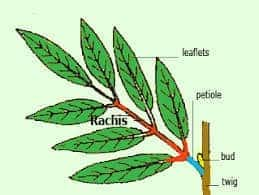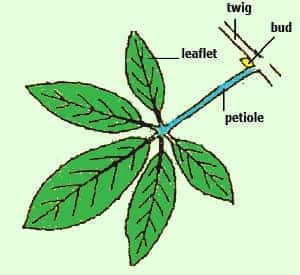NCERT Solutions for Class 11 Biology Chapter 5 - Morphology of Flowering Plants
The NCERT Solutions for Class 11 Biology Chapter 5 Morphology of Flowering Plants explores the external features of plants. The chapter explains each part of the plant from roots to flowers. Answers are provided with simple explanations and easy-to-understand language. Different well-labeled diagrams are added by subject experts to make learning effective. The NCERT Solutions boost confidence and are useful to score well in school exams and in competitive exams like NEET.
This Story also Contains
- Download Morphology of Flowering Plants Class 11 Questions and Answers PDF
- Access Class 11 Biology Chapter 5 Morphology of Flowering Plants Question Answer
- Approach to Solve Morphology of Flowering Plants Class 11 Question Answer
- Important Questions of NCERT Class 11 Biology Chapter 5 Morphology of Flowering Plants
- What Students Learn from the Morphology of Flowering Plants NCERT Solutions?
- Why Class 11 Biology Chapter 5 Morphology of Flowering Plants NCERT Solutions are Important?
- What Extra Should Students Study Beyond the NCERT for NEET?
- Chapter-Wise NCERT Solutions for Class 11 Biology
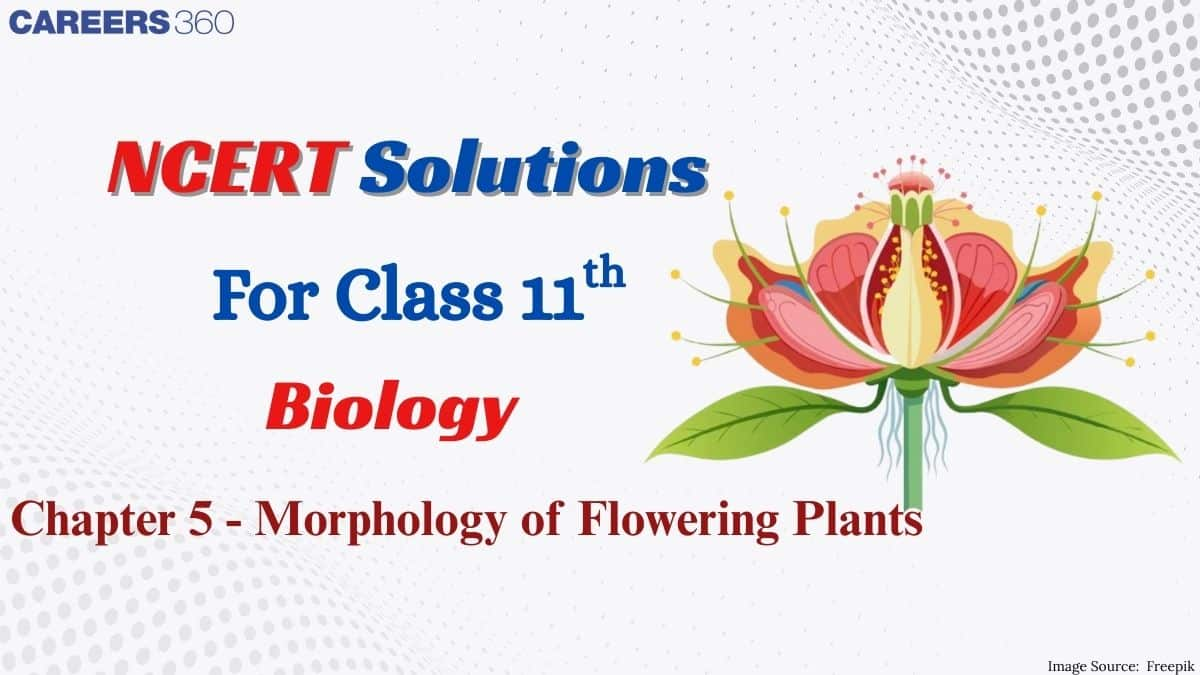
The Morphology of Flowering Plants Class 11 question answer explains different types of stems, roots, and their modifications. Flowers, fruits, and seeds are also included with different examples, along with special modifications that have structural and functional importance. Morphology of Flowering Plants Class 11 questions and answers PDF is prepared in such a way that students learn how to write answers in an exam, without any confusion.
Download Morphology of Flowering Plants Class 11 Questions and Answers PDF
Chapter 5 becomes easier to study when students get simple and clear solutions. Different parts of a plant, like roots, stems, leaves, flowers, and fruits, are included. Students can download the Morphology of Flowering Plants Class 11 questions and answers PDF from the link given below. They can use NCERT Solutions for Class 11 Biology to revise quickly and learn better.
Also Read,
Access Class 11 Biology Chapter 5 Morphology of Flowering Plants Question Answer
The detailed explanations of all the questions given in the textbook are given below. All answers are prepared in simple language by the subject experts, according to the latest NCERT guidelines. Practicing the Class 11 Biology Chapter 5 Morphology of Flowering Plants question answer allows students to improve their understanding.
Question 1. How is a pinnately compound leaf different from a palmately compound leaf?
Answer:
Pinnately compound leaf | Palmately compound leaf |
In Pinnately compound leaves, several leaflets are present on a common axis called the rachis. Example- Neem. | In Palmately compound leaves, the leaflets are attached at a common point. Example- Silk cotton. |
|
|
Question 2. Explain with suitable examples the different types of phyllotaxy.
Answer:
The pattern of arrangement of leaves on the stem or branch is called Phyllotaxy. There are three types of phyllotaxy found in plants.
1. Alternate phyllotaxy- On a branch, a single leaf arises at each node. E.g., China rose
2. Opposite phyllotaxy- At one node, two leaves arise, opposite to each other. E.g., a guava plant
3. Whorled phyllotaxy- More than two leaves arise at a node and form a whorl in whorled phyllotaxy. E.g., Alstonia
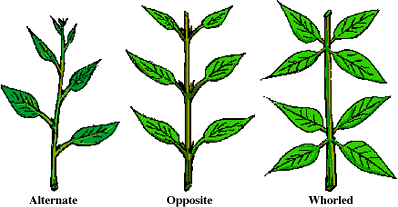
Question 3. Define the following terms:
(a) aestivation
Answer:
Aestivation- The mode of arrangement of sepals or petals in the floral bud, concerning the other members of the same whorl, is called aestivation. Aestivation in plants can be valvate, wavy, imbricate, and vexillary.
Question 3. Define the following terms:
(b) placentation
Answer:
Placentation- The arrangement of ovules within the ovary is called placentation. There are five types of placentation found in plants, including marginal, basal, parietal, axile, and free central placentation.
Question 3. Define the following terms:
(c) actinomorphic
Answer:
Actinomorphic- The flowers that can be divided into two radial halves by any radial plane passing through their centre are called actinomorphic flowers. E.g., chili and mustard.
Question 3. Define the following terms:
(d) zygomorphic
Answer:
Zygomorphic- The flowers that can be divided into two similar halves by a single vertical plane only are known as zygomorphic flowers. E.g., peas and beans.
Question 3. Define the following terms:
(e) superior ovary
Answer:
Superior ovary- When the gynoecium is present at the highest position, while other floral parts are arranged below it, the ovary is said to be a superior ovary. A flower with this arrangement is described as hypogynous. Examples include brinjal and mustard.
Question 3. Define the following terms:
(f) perigynous flower
Answer:
Perigynous flower- When the gynoecium is present in the center, while the rest of the floral parts are present at the rim of the thalamus at the same level as the gynoecium, the flower is called a perigynous flower. E.g., plum and rose.
Question 3. Define the following terms:
(g) epipetalous stamen
Answer:
Epipetalous stamen- The stamen that remains attached to the petals is called epipetalous stamen. E.g., brinjal
Question 4. Differentiate between
(a) Racemose and cymose inflorescence
Answer:
Racemose inflorescence | Cymose inflorescence |
The main axis of the flower continues to grow and produce flowers laterally in a racemose inflorescence | The main axis of the flower has limited growth and terminates in a flower. |
Flowers grow in acropetal succession. The younger flowers are present at the tip, while the older flowers are found at the base. | The older flowers are present at the tip, whereas the younger flowers are found at the base of the axis. |
Question 4. Differentiate between
(b) Apocarpous and syncarpous ovary
Answer:
Apocarpous ovary | syncarpous ovary |
In a flower, when more than one free carpel is present, the ovary is called the apocarpous ovary | In a flower, when more than one carpels are found and they are fused, the ovary is called a syncarpous ovary. |
Examples of the apocarpous ovary include lotus and rose | Examples of the syncarpous ovary include mustard and tomato |
Question 5. Draw the labeled diagram of the following:
(i) gram seed
Answer:
Structure of gram seed-
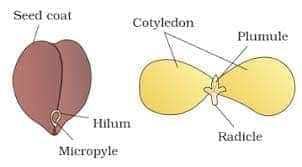
Question 5. Draw the labeled diagram of the following:
(ii). V.S. of maize seed
Answer:
V.S. of maize seed
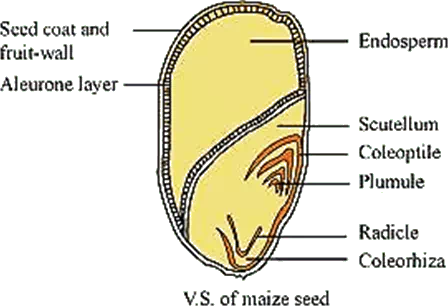
Answer:
Family Solanaceae- The herbaceous, upright vine Solanum nigrum has reticulate leaf venation and no stipules. To create the upright habit, the stem is additionally branched. This plant produces actinomorphic, bisexual flowers in solitary, axillary inflorescences. Five persistent conjoined sepals with valvate aestivation make up the calyx, while five petals with valvate aestivation make up the corolla. It has an androecium made up of five epipetalous stamens. The gynoecium is a bi-carpellary syncarpous superior ovary with axile placentation. The seed is endospermous, while the fruit is a berry. There are numerous medicinal applications for Solanum nigrum.
Floral diagram:

Question 7. Describe the various types of placentations found in flowering plants
Answer:
Placentation is the positioning of ovules in the ovary of a flower. Plants may have 5 different types of placentation. They are as follows:
1. Marginal placentation: The placenta develops as a ridge along the ventral suture of the ovary, and the ovules mature on two distinct rows in marginal placentation, e.g., peas.
2. Parietal placentation: If the ovules grow against the inner wall of the ovary, the ovary will be called to have parietal placentation.
3. Axile placentation: Here, the placenta will be axial and will have attached to it the ovules, e.g., China rose, lemon, and tomato.
4. Basal placentation: In basal placentation, the placenta grows from its base, and there is one ovule attached to the base. It occurs in marigolds and sunflowers.
5. Free central placentation: The septa are missing in free central placentation as the ovules are present on the central axis. Dianthus and primrose are the plants exhibiting free central placentation.

Question 8. What is a flower? Describe the parts of a typical angiosperm flower.
Answer:
A flower is the reproductive organ of angiospermic plants for sexual reproduction. A general flower consists of four whorls on the swollen tip of the stalk or pedicle known as the thalamus. They include Calyx, Corolla, Androecium, and Gynoecium.
1. Calyx- It is the outermost whorl of a flower. It is composed of units known as sepals. It is usually green in color and protective in function.
2. Corolla- It is the whorl that occurs within the Corolla. It comprises petals. The petals are vividly coloured to entice the insects.
3. Androecium- It is the whorl occurring beside the corolla. The androecium contains primarily stamens, which are the male reproductive parts of a flower. A stamen has two components, i.e., an anther and a filament. The anther is a bilobed body having a stalk referred to as a filament. Within the anther, the pollen grains develop.
4. Gynoecium- The innermost whorl of the flower is known as the gynoecium. It comprises pistils. A pistil has three constituents: stigma, style, and ovary. Pistils are the female reproductive units of a flower.
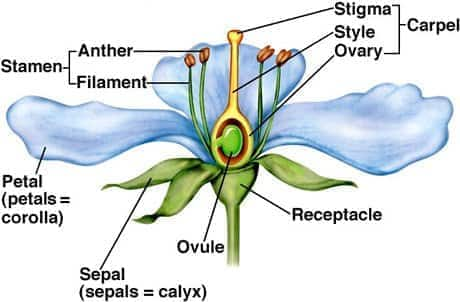
Answer:
The arrangement of flowers on the floral axis is termed inflorescence. There can be two types of inflorescence, i.e., racemose and cymose, based on whether the floral axis continues to grow or ends in a flower. In a racemose inflorescence, the floral axis continues to grow and bear flowers, whereas in a cymose inflorescence, the floral axis stops growing and terminates in a flower.
Question 10. Describe the arrangement of the floral members about their insertion on the thalamus.
Answer:
There may be three kinds of floral member arrangements around their insertion into the thalamus. These are:
1. Hypogynous – The Ovary is at the topmost position, and the remaining parts are at a lower level than the ovary. The ovary in such flowers is known as superior. E.g., Brinjal, mustard, and China rose. The flowers with such an arrangement are termed hypogynous flowers.
2. Perigynous -In this type, the gynoecium is placed in the center, and other structures are on the edge at the same level. This type of ovary is referred to as half-inferior, and flowers are perigynous.
3. Epigynous- Here, the ovary lies below all the other structures. The ovary here is referred to as inferior, whereas the flower is referred to as an epigynous flower.
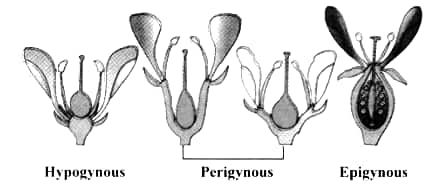
NCERT Solutions for Class 11: Subject-wise
Approach to Solve Morphology of Flowering Plants Class 11 Question Answer
The Morphology of Flowering Plants includes many concept-based questions. Given below are some effective ways to answer the questions effectively.
Students first need to understand the meaning of terms like root, stem, leaf, inflorescence, flower, fruit, and seed.
After that, making quick notes with examples is important to revise easily. Students can take help from the Class 11 Biology Chapter 5 Morphology of Flowering Plants question answer.
Many questions in the exam are directly taken from the NCERT textbook. That's why it is important to read and understand each line thoroughly.
Labeled diagrams are very important. Different types of roots, leaves, and floral structures need to be practiced from the Class 11 Biology Morphology of Flowering Plants question answer.
Try to solve previous-year questions and in-text exercises to get familiar with the pattern. To gain confidence in the upcoming exams, refer to the NCERT Solutions for Class 11.
Also, check the NCERT Books and the NCERT Syllabus here :
Important Questions of NCERT Class 11 Biology Chapter 5 Morphology of Flowering Plants
Here is an important question from this chapter, along with the solution. Solving different questions allows students to improve their problem-solving skills. For more such questions, they can refer to the NCERT Solutions for Class 11 Biology Chapter 5 Morphology of Flowering Plants.
Question 1: Endosperm, a product of double fertilization in angiosperms, is absent in the seeds of
A. Coconut
B. Maize
C. Orchids
D. Castor
Answer:
The endosperm may be completely consumed by the developing embryo (e.g., pea, groundnut, beans) before seed maturation. Such seeds are called non-endospermic or exalbuminous. It may persist in the mature seed (e.g., castor and coconut) and be used up during seed germination. Such seeds are called endospermic or albuminous.
The embryo in the orchid plant absorbs the endosperm during growth.
Hence, the answer is option (C) Orchids.
Question 2: The placenta is attached to the developing seed near the
A. Hilum
B. Testa
C. Micropyle
D. Chalaza
Answer:
The scar on the seed coat through which the seed attaches itself to the fruit is known as the Hilum. Chalaza is the base of the ovule, Testa is the outer covering of the seed, and lastly, micropyle is a tiny opening in the seed coat through which water gets absorbed in the seed.
Hence, the answer is option (A) Hilum.
Question 3: Roots developed from parts of the plant other than the radicle are called
A. Taproots
B. Adventitious roots
C. Fibrous roots
D. Nodular roots
Answer:
Plant roots known as adventitious roots can emerge from any non-root tissue, including the stem, leaves, or subterranean structures. They may occur as a result of stressors or as a result of regular development. Some adventitious roots—also referred to as aerial roots—either hang in midair or travel a considerable distance through the atmosphere before touching down. Some of these eventually help to maintain the plant in the soil, as those found in screw pine, banyan, and corn (maize).
Hence, the answer is option (B) Adventitious roots.
Question 4: Which of the following plants is used to extract the blue dye?
A. Trifolium
B. Lupin
C. Indigofera
D. Cassia
Answer:
Indigo is a natural blue dye historically derived from the plant Indigofera, most commonly Indigofera Tinctoria a genus of flowering plants in the Family Fabaceae. The leaves of Indigofera contain a chemical that turns bluish on exposure to air. Blue dye is widely used in the textile industry as a dye for cotton yarn, primarily in the production of denim cloth suitable for blue jeans.
Hence, the answer is option (C) Indigofera.
Question 5: Venation is a term used to describe the pattern of arrangement of
A. Veins and veinlets in a lamina
B. Flower in inflorescence
C. Floral organs
D. All of them
Answer:
The veins of the leaves, which carry the food and water, are designed in a complex net-like structure. This complex arrangement of veins in a leaf is called venation. Veination is of two types based on the arrangement of veins and veinlets.
Hence, the answer is option (A) Veins and veinlets in a lamina.
Question 6: The type of inflorescence in which the main axis continues to grow and the flowers are borne laterally in an acropetal succession, is known as
A. Cymose
B. Racemose
C. Capitulum
D. Cyathium
Answer:
In a racemose inflorescence, the main axis grows indefinitely, and flowers are arranged laterally in acropetal succession-younger flowers are towards the apex and older ones at the base. In contrast, cymose inflorescence has limited growth and shows basipetal succession of flowers.
Hence, the answer is option (B) Racemose.
Question 7: A fruit developed from a single flower with multiple free carpels is called
A. Aggregate fruit
B. Multiple fruit
C. Simple fruit
D. Composite fruit
Answer:
When a single flower contains many free carpels, and each carpel forms a separate fruitlet, the cluster of these fruitlets together forms an aggregate fruit (e.g., strawberry, raspberry).
Hence, the answer is option (A) Aggregate fruit.
What Students Learn from the Morphology of Flowering Plants NCERT Solutions?
In this chapter, students explore the external features of flowering plants and their adaptations. Many interesting facts about the flower are included in this chapter.
Students learn about the types of root systems, their modifications, and their specific functions.
The Morphology of Flowering Plants Class 11 question answer explains the structure and varieties of stems along with their modifications.
Students also study the technical descriptions of typical flowering plants and the use of floral formulas.
Leaves, their venation, phyllotaxy, and modifications are discussed in detail with examples.
The Class 11 Biology Morphology of Flowering Plants question answer covers the structure of flowers, inflorescence, fruits, and seeds.
Why Class 11 Biology Chapter 5 Morphology of Flowering Plants NCERT Solutions are Important?
The Morphology of Flowering Plants chapter allows students to understand the external structure of plants and important terminologies that are used to describe different plant parts. Different modifications of the root, stem, leaf, flower, and fruit, along with examples, are included.
- Class 11 Biology Chapter 5 Morphology of Flowering Plants NCERT Solutions help students learn the terms and different plant parts correctly.
- The solutions also help them know different types of roots, venation patterns, leaf modifications, and inflorescences, along with examples.
- Students also gain clarity on the floral formula, floral diagram, and the features of important plant families such as Fabaceae, Solanaceae, and Liliaceae.
- Plant adaptations and how they survive in different environmental conditions are also included in the solutions, which are important for board and competitive exams like NEET.
What Extra Should Students Study Beyond the NCERT for NEET?
For the NEET exam, NCERT is very helpful, but learning a few extra things can give students extra help. Focus on important terms and diagrams to improve the understanding. Students can also refer to the NCERT Solutions for Class 11 Biology Chapter 5 Morphology of Flowering Plants to revise concepts quickly.
Chapter-Wise NCERT Solutions for Class 11 Biology
Below are the chapter-wise solutions designed to help students understand each topic clearly and practice important questions effectively.
Frequently Asked Questions (FAQs)
This chapter focuses on the external structure (morphology) of flowering plants, including roots, stems, leaves, inflorescence, flowers, fruits, seeds, and the description of some important plant families.
- The NCERT Solutions for Class 11 Biology Chapter 5 Morphology of Flowering Plants include all questions and help you get through the chapter well.
- Reading this chapter helps you get better marks in board exams and is helpful for competitive exams such as NEET.
- The PDF solutions make revision easier and improve your knowledge.
The important topics included in the NCERT Solutions for Class 11 Biology Chapter 5 Morphology of Flowering Plants are given below:
- The Root
- The Stem
- The Leaf
- The Inflorescence
- The Flower
- Fruit
- The Seed
- Semi-technical Description of a Typical Flowering Plant
- Description of Some Important
This chapter builds the foundation for botany topics in higher classes and competitive exams like NEET. It helps students recognize plant structures during practicals and understand their modifications and functions in detail.
The stem in flowering plants serves several important functions, which are given below:
Support – Gives structural support to leaves, flowers, and fruits.
Conduction – Carries water and minerals from roots to leaves and food from leaves to other parts through the xylem and phloem.
Storage – Stores food, water, and nutrients in certain plants (e.g., potato, ginger).
Photosynthesis – Photosynthesis takes place in certain green stems (e.g., cactus).
Protection – Certain stems produce thorns for protection (e.g., Bougainvillea).
The two most common types of venation in leaves are:
- Reticulate Venation – The veins are network-like in pattern and widespread in dicots (e.g., mango, peepal).
- Parallel Venation – The veins are parallel to one another present in monocots (e.g., grass, banana).
- Pinnate Venation – A form of reticulate venation with a central main vein and lateral branches (e.g., guava).
- Palmate Venation – Several main veins emerge from one point (e.g., maple, castor).
- Furcate Venation – Veins branch dichotomously without anastomosis (e.g., leaves of fern).
Simple leaves possess one, undivided lamina, whereas compound leaves possess a divided lamina into several leaflets. Incisions in simple leaves can be present but not extending to the midrib (e.g., mango, guava). Compound leaves possess a stalk for each leaflet but on a shared axis (e.g., neem, rose).
The placentation types in flowering plants are:
- Marginal Placentation – The ovules are located along the margin of the ovary (e.g., pea).
- Axile Placentation – Ovules are supported on a central axis within a multilocular ovary (e.g., tomato, lemon).
- Parietal Placentation – Ovules grow against the inner walls of an unilocular ovary (e.g., mustard).
- Basal Placentation – One ovule is fixed at the base of the ovary (e.g., sunflower).
- Free Central Placentation – Ovules are supported by a central column with no septa (e.g., dianthus, primrose).
Courses After 12th
Applications for Admissions are open.
As per latest syllabus. Physics formulas, equations, & laws of class 11 & 12th chapters
JEE Main Important Chemistry formulas
Get nowAs per latest syllabus. Chemistry formulas, equations, & laws of class 11 & 12th chapters
JEE Main high scoring chapters and topics
Get nowAs per latest 2024 syllabus. Study 40% syllabus and score upto 100% marks in JEE
JEE Main Important Mathematics Formulas
Get nowAs per latest syllabus. Maths formulas, equations, & theorems of class 11 & 12th chapters
